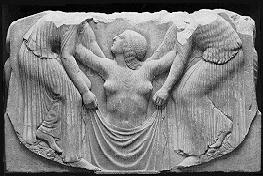|
Locri Epizefiri, with its vast territory, was impervious to italic influence because of its aristocratic constitution, and so continued to develop luxury goods for the domestic market in the Greek Style. |
 |
 |
 |
| These votive plaques, or pinakes, are the only stylistic parallel to the Ludovisi Throne, which combines the ionicism of the late Archaic period with a variant of the 'Severe' style. The treatment of drapery, the use of depth, and the movement depicted is similar to that of the votive plaques. On the left is a pinax depicting the Rape of Persephone, on the right a pinake showing Eros pulling Hermes and Aphrodite. When compared with the Ludovisi Throne, the similarities in design become apparent. | Recent studies of the temple of Aphrodite in Locri have shown that the Ludovisi Throne would have fitted exactly into the blocks remaining in the temple floor. The subject matter of the Throne also ties in with the those of the plaques, and their relation to Locri Epizefiri and its cults. Locri Epizefiri seems the most likely place that the Ludovisi Throne was made, but there are still some problems in linking it with Sculpture in Magna Graecia. |